|
Summary
|
|
|
|
An explicit model of High Dilutions used for therapeutical
approach of the Homoeopathic Doctrine is presented.
Heuristical points of view of High Dilution theory are reminded and
experimental illustrations are shown.
|
| |
|
Introduction
|
| |
|
Since two hundred years, the obtention of therapeutical
results when using preparations having no active principles,
with the Avogadro meaning, remains a scientific enigma.
To answer to the Samuel HAHNEMANN question :
<< What really happens has to be at least possible>>,
four authors propose a theoretical model and the experimental
validation of the diluted-succussed solutions used in the
therapeutical frame of the homoeopathic doctrine.
The present work is multi disciplinary and interdisciplinary.
It is presented in two books entitled Theory of High
Dilutions & Experimental aspects (1).
This lecture is focus on the heuristical points of view of the
theory and on a synthesis of the experimental aspect.
|
| |
|
Equipment and Method
|
| |
Measures were carried on a large range of
diluted-succussed solutions, prepared under different
physico-chemical situations well controlled (2),
on human biological liquids, animal biological liquids
(cats, horses, cows, snakes...), organ extracts and on
cellular cultures.
The theoretical methods applied are based on the current
corpus of science: Theory of Ethers (3), Quantum Theory of the
Relativistic Fields, Contonian Statistics (4).
The experimental methods are those
commonly used: Nuclear Magnetic Resonance
(Minispec from Brücker S.A), Liquid Scintillation
(Tricarb 19006 from Packard S.A), computers (Hewlett Packard 200MHz,
Power Macintosh 200MHz). The dilutions-succussions are performed
according to the classical principles, the succussion machine
designed by Ecosem S.A allowing not only to measure the energy
introduced during the succussion but also to remake exactly
the same each given diluted-succussed solution.
Finally, various conventional equipment are also used:
ultrasonic devices, magnetic field generators, incubators,
freezers, automatic pipettes, and so on .....
|
| |
|
Results
|
|
|
White Holes and Hyper Protons
The theoretical calculations as well as the experimental
results raise in evidence the following points:
The dilution process
induces a progressive disappearance of the matter contained
in a given milieu, disappearance that corresponds to a
dematerialization and leads to the birth of what we have
named "White Holes." This name was choose in opposition
to the "Black Holes" of the astronomers in which the matter
is infinitely concentrated when in our White Holes
the matter has totally disappeared.
When such White Holes exist in a given milieu, fields are created
that induce an heterogeneity of the milieu.
These fields will govern spatio-temporal singularities with
regard to the molecules existing in the milieu.
When one of these particles, neutron of the water for instance,
is faced, at the quantum level, to what we have named a White Hole,
it will not be able to decide, and that are quantum conditions,
between two possibilities: disappear in this White Hole or continue
on its line of universe with the Einstein meaning.
This hesitation period will induce the modification of the
quantum state of the particle.
- The succussion process
will increase the encounter of the neutronic type physical
fields, that are non charged and non magnetic, with the
molecules of the milieu and induce what we have named Hyper
Protons. These Hyper protons are virtual particles quantumly
characterized which, under certain conditions and according
to the masse exchange, will create, for instance, Hydrogen,
Deuterium, Tritium.
A such rematerialization depends on the gravitation and gives birth
to Beta type radiations.
Tritium creation in homoeopathic solutions has been measured. Initially, the measured radioactivity of these solutions was equal to 20 CPM, that is to say 20 pulses/minute and, one year later, the radioactivity measured was of 414 CPM. This is indeed a low value but it represents the last step of the different rematerializations.
|
| |
|
The fundamental equation that illustrates these reactions
is given hereunder for memory.
The electrons, under the influence of a
materialization-dematerialization phenomenon and the
influence of the gravitation correspond to the well known
chronological products: Sum of the integral of
the electronic energies multiplied by the gravitation
variation.
|
| |
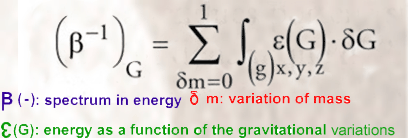
|
|
We have been able to verify that the nuclear disintegrations
induce the same phenomenon in the environmental milieu.
|
|
Contonian Statistics
The contonian statistics, that is a non probabilistic
statistics, consists in calculating the surface laying
under a curve drawing and reporting these points as a
function of the dilution-succussion levels.
Such doing, the initial semi-chaotic aspect of the
curve becomes perfectly linear. (Fig 1)
|
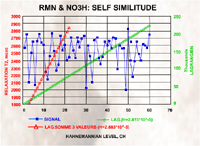 |
| Figure 1 |
|
From a such straight line, named Lagrangian,
one evaluates the contonian frequency of the dynamic system,
frequency that is simply expressed by:
2 Pi / maximum Lag.
This contonian frequency is characteristic of the matter
having disappear from the considered milieu whatever the
nature of this milieu is: aqueous or non such as the lactose
for instance.
So, the contonian statistics allows the coupling of dynamic
systems and the calculation of the phases and of the phase
displacements.
Pathologies may be considered as phase displacements, the diluted
and succussed solutions being used to modified these phase
displacements in order to bring back the health status.
|
| |
|
Nuclear Magnetic Resonance
|
|
NMR consists in putting the milieu to be observed
inside a permanent magnet and surrounding this magnet
by a coil that is a radio-frequencies wave
transmitter-receiver that leads to the protons orientation.
When protons are oriented, one will perturb them by
radio-frequency waves.
When the radio-frequencies are increased, the return time
to the equilibrium is named T1 or spin-lattice relaxation
time and, when they are decreased, the return time is named
T2 or spin-spin relaxation time.
Right away, this method had given extremely different
results for only diluted aqueous solutions and for diluted
and succussed aqueous solutions.
Such type of experiment is summarized on the figure 2.
|
|
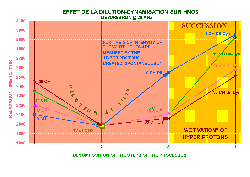 |
|
| Figure 2 |
|
Measures are made on four nitric acid solutions,
referred as 8CH, 18CH, 14CH, 29CH, the Avogadro number
having be passed at the 12CH level. Then, these solutions are
diluted and a new measure is done on each solution after the
dilution. Then, one waits a certain time to allow the
evolution of these solutions and a new measure is done
on each solution. One of the solutions is noticeable:
the one being lower than the Avogadro number, that is to say,
the one that still contains some molecules:
the 9CH, coming from the 8CH, increases spontaneously its
relaxation time after the dilution, what corresponds to the
continuation of dematerialization phenomenon, the dilution
process inducing systematically a dematerialization.
If after this rest period the solutions are succussed, the relaxation
time of all of them increases. If the relaxation times increase,
that means that the dynamic of the milieu is also increased.
Here we still have a translation of the mathematical theory:
- a step of White Holes creation
linked to thedilution,
- a step of amplification of the phenomenon linked to the succussion.
|
|
|
Liquid Scintillation
|
|
The theoretical prediction of the apparition of Beta type
radiations during the rematerialization was experimentally
raised in evidence by autoradiography and, even better,
by Liquid Scintillation counting.
Thanks to this technics, we have been able to calculate the
energy of the Beta emitted by homoeopathic solutions,
by biological milieus, by plants... This approach allowed us to quantify the phenomenon intensity
not only in the diluted-succussed solutions but also in
biological milieus. (Figure 3).
|
|
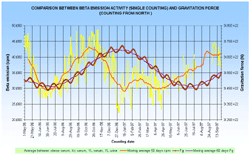
|
|
| Figure 3 |
|
According to the quantum theory, in our formalization,
gravitation impacts on the materialization-dematerialization.
As shown by the dates mentioned on this figure,
experiments started on May 1st, 1996. They are still in progress.
This figure shows the gravitation curve calculated
according to Newton and representing the gravitation
variations as well as the curve of the variations of
the Beta activity measured on biological milieus.
This figure presents the average between the serum of
an obese, serum of a cancer victim, a reference serum
and a reference urine. Each of these aspects can be
differentiated. An obese does not have the same amplitude
than a cancer victim who, himself, does not have the same
amplitudes than the reference.
Using the Liquid Scintillation, we could also show that the
wave-energy lengths of the Beta radiations are between 0,1
and 60 KeV, the Beta spectrum are a function of the dilution
level and still exist beyond the Avogadro number.
Figure 4 illustrates results related to histaminum.
|
|
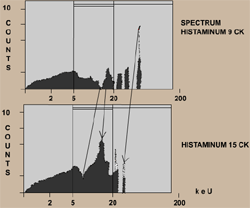 |
| Figure 4 |
|
|
Discussion - Conclusion
|
|
Results obtained the two past years have confirmed the
previous measurements and the proposed model has not be
in question. At the present time, our works are consistent
and coherent.
In this first step, the aim of our work was the following:
insert the diluted-succussed solution within the Corpus of Science and, so doing, give a scientific basis to the Homoeopathic Doctrine.
Beyond the explanatory aspect, the mastery of the solutions
preparation is ensured, allowing so to control and quantify
their effects in vitro as well as in vivo.
As a conclusion, it can be said that the expected
contribution of this new theory must be of prime importance.
|
|




